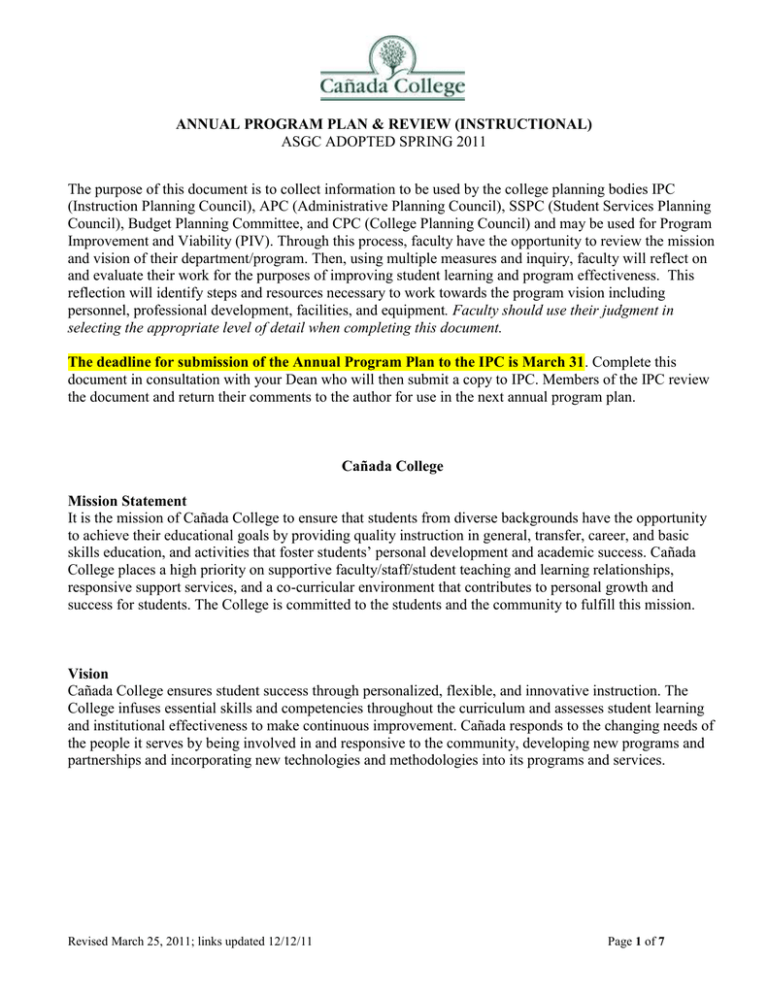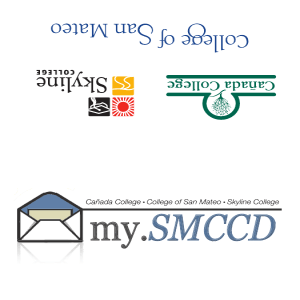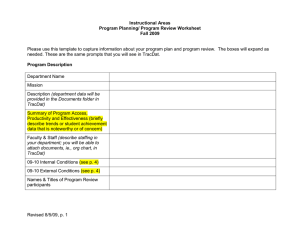ASGC ADOPTED SPRING 2011 ANNUAL PROGRAM PLAN & REVIEW (INSTRUCTIONAL)
advertisement

ANNUAL PROGRAM PLAN & REVIEW (INSTRUCTIONAL) ASGC ADOPTED SPRING 2011 The purpose of this document is to collect information to be used by the college planning bodies IPC (Instruction Planning Council), APC (Administrative Planning Council), SSPC (Student Services Planning Council), Budget Planning Committee, and CPC (College Planning Council) and may be used for Program Improvement and Viability (PIV). Through this process, faculty have the opportunity to review the mission and vision of their department/program. Then, using multiple measures and inquiry, faculty will reflect on and evaluate their work for the purposes of improving student learning and program effectiveness. This reflection will identify steps and resources necessary to work towards the program vision including personnel, professional development, facilities, and equipment. Faculty should use their judgment in selecting the appropriate level of detail when completing this document. The deadline for submission of the Annual Program Plan to the IPC is March 31. Complete this document in consultation with your Dean who will then submit a copy to IPC. Members of the IPC review the document and return their comments to the author for use in the next annual program plan. Cañada College Mission Statement It is the mission of Cañada College to ensure that students from diverse backgrounds have the opportunity to achieve their educational goals by providing quality instruction in general, transfer, career, and basic skills education, and activities that foster students’ personal development and academic success. Cañada College places a high priority on supportive faculty/staff/student teaching and learning relationships, responsive support services, and a co-curricular environment that contributes to personal growth and success for students. The College is committed to the students and the community to fulfill this mission. Vision Cañada College ensures student success through personalized, flexible, and innovative instruction. The College infuses essential skills and competencies throughout the curriculum and assesses student learning and institutional effectiveness to make continuous improvement. Cañada responds to the changing needs of the people it serves by being involved in and responsive to the community, developing new programs and partnerships and incorporating new technologies and methodologies into its programs and services. Revised March 25, 2011; links updated 12/12/11 Page 1 of 7 ANNUAL PROGRAM PLAN & REVIEW (INSTRUCTIONAL) ASGC ADOPTED SPRING 2011 Document Map: 0) 1) 2) 3) 4) 5) 6) 7) 8) Key Findings Planning group Authors Program Responses to previous Annual Program Plan &Review (APP&R) Curricular Offerings Program Level Data Action Plan Resource Identification Revised March 25, 2011; links updated 12/12/11 Page 2 of 7 ANNUAL PROGRAM PLAN & REVIEW (INSTRUCTIONAL) ASGC ADOPTED SPRING 2011 Note: To complete this form, SAVE it on your computer, then send to your Division Dean as an ATTACHMENT to an e-mail message. Department/Program Title: Date submitted: 0. Key Findings: 1. Planning Group (include PT& FT faculty, staff, stakeholders) List of names and positions: 2. Writing Team and Contact Person: 3. Program Information A. Program Personnel Identify all personnel (faculty, classified, volunteers, and student workers) in the program: FT Faculty PT Faculty PT Classified (hrs/wk) FTE FT Classified Volunteers Student Workers B. Program mission and vision Include the purpose of the program, the ideals the program strives to attain, and whom the program serves. The program mission and vision must align with the college’s mission and goals. (200 word limit) C. Expected Program Student Learning Outcomes Tool: TracDAT folders in the SLOAC sharepoint. Click on the link below to access your folder and log in with your complete smccd e-mail account, ex:smithj@smccd.edu and password http://sharepoint.smccd.edu/SiteDirectory/CANSLOAC List expected Program Student Learning Outcomes (PSLOs) (minimum of 3) and assessment tools for each. Guideline: List knowledge, skills, abilities, or attitudes upon completion of program or significant discipline work and list assessment tools. Can be copied from Tracdat. Revised March 25, 2011; links updated 12/12/11 Page 3 of 7 ANNUAL PROGRAM PLAN & REVIEW (INSTRUCTIONAL) ASGC ADOPTED SPRING 2011 4. Response to Previous Annual Program Plan & Review Tool: http://sharepoint.smccd.edu/SiteDirectory/canio/ipc (log in with your complete smccd e-mail account, ex: smithj@smccd.edu and password) List any recommendations for the program and your responses to these recommendations based on previous Annual Program Plan and/or CTE Professional Accreditation report. Guideline: Original documents can be linked or attached, as needed. 5. Curricular Offerings (current state of curriculum and SLOAC) All curriculum and SLOAC updates must be completed when planning documents are due. SLOAC = Student Learning Outcomes Assessment Cycle Tools: TracDAT folders in SLOAC sharepoint http://sharepoint.smccd.edu/SiteDirectory/CANSLOAC Curriculum Committee http://sharepoint.smccd.edu/SiteDirectory/cancurriculum/ A. Attach the following TracDat and Curriculum data in the appendix: List courses, SLOs, assessment plans, and results and action plans (attach report from TracDAT folders in SLOAC sharepoint). List courses with COR’s over 6 years old (attach documents from Curriculum Committee) B. Identify Patterns of Curriculum Offerings Guidelines: What is the planning group’s 2-year curriculum cycle of course offerings by certificates and degrees? What is the ideal curriculum cycle? Discuss any issues. 6. Program Level Data A. Data Packets and Analysis from the Office of Planning, Research & Student Success and any other relevant data. Tool: http://www.canadacollege.edu/inside/research/programreview/info_packet/info_packet.html Revised March 25, 2011; links updated 12/12/11 Page 4 of 7 ANNUAL PROGRAM PLAN & REVIEW (INSTRUCTIONAL) ASGC ADOPTED SPRING 2011 Guidelines: The data is prepared by the Office of Planning, Research & Student Success and is to be attached to this document. Include the following: Describe trends in the measured parameters. Reflect and analyze causes of trends. B. Analyze evidence of Program performance. Explain how other information may impact Program (examples are business and employment needs, new technology, new transfer requirements) Tool: TracDAT folders in SLOAC sharepoint http://sharepoint.smccd.edu/SiteDirectory/CANSLOAC Guidelines: Explain how the assessment plan for Program Student Learning Outcomes (listed on #3c) measures quality and success of each Program. Summarize assessment results of Program Student Learning Outcomes. Describe and summarize other data that reveals Program performance. Explain how changes in community needs, technology, and transfer requirements could affect the Program. C. Other Considerations 7. Action Plan Include details of planning as a result of reflection, analysis and interpretation of data. Guidelines: Describe data and assessment results for Program Student Learning Outcomes. Analyze and reflect on assessment results for Program Student Learning Outcomes and other measures of Program performance. Analyze and reflect on other evidence described in previous sections. Identify the next steps, including any planned changes to curriculum or pedagogy. Identify questions that will serve as a focus of inquiry for next year. Determine the assessments; set the timeline for tabulating the data and analyzing results. Describe what you expect to learn from the assessment efforts. Revised March 25, 2011; links updated 12/12/11 Page 5 of 7 ANNUAL PROGRAM PLAN & REVIEW (INSTRUCTIONAL) ASGC ADOPTED SPRING 2011 8. Resource Identification A. Faculty and Staff hiring requests Guidelines: Explain clearly and with supporting data showing how hiring requests will serve Department/Division/College needs. Include information from the most recent Comprehensive Program Review or Annual Program Plan, whichever was last year’s document. B. Professional Development needs Guidelines: List faculty and staff professional development activities. Describe faculty and staff professional development plans for next year. Explain how professional development activities improved student learning outcomes. C. Classroom & Instructional Equipment requests Guidelines: List classroom & instructional equipment requested, including item description, suggested vendor, number of items, and total cost. Explain how it will serve Department/Program/Division/College needs. List the requests (item description, suggested vendor, number of items, and total cost). List special facilities and equipment that you currently use and require. D. Office of Planning, Research & Student Success requests Guidelines: List data requests for the Office of Planning, Research & Student Success. Explain how the requests will serve the Department/Program/Division/College needs. Revised March 25, 2011; links updated 12/12/11 Page 6 of 7 ANNUAL PROGRAM PLAN & REVIEW (INSTRUCTIONAL) ASGC ADOPTED SPRING 2011 E. Facilities requests Guidelines: List facilities requests. Explain how the requests will serve the Department/Program/Division/College needs. Revised March 25, 2011; links updated 12/12/11 Page 7 of 7


